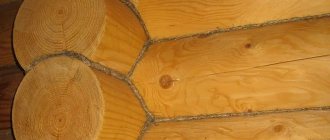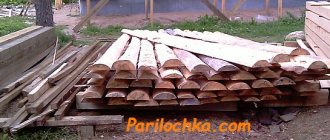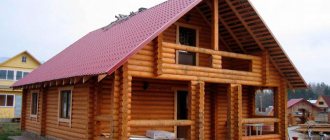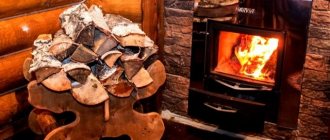In general, it is very interesting to apply bath specifics to the entire range of commercially available finishing materials.
For sauna and steam bath: is there a difference?
In our country, people don’t always distinguish a bathhouse from a sauna, let alone talk about any specific materials.
In fact, there may not be , because the operating conditions are approximately the same, only in one case the humidity will be higher, in the other - the temperature.
Of course, we are talking about a steam room. It is different in Russian and Finnish baths only in design. And the materials used are the same: wood, stone, glass, metal.
Of course, the Finns set the fashion for what a sauna looks like. Therefore, saunas often look more modern than Russian baths. This is achieved precisely through certain finishing elements and materials.
What are these elements? Well, firstly, the use of paints and varnishes in the sauna becomes acceptable . This is quite progressive, considering that lovers of Russian baths are suspicious and negative about any “chemistry” in the steam room. And among the Finns, wood can be coated with acrylic varnish in any shade. This brings variety to the way their sauna interiors look.
Secondly, it is already customary that the door to the sauna is made of a material such as heat-resistant glass (see about them here).
Thirdly, the design is more modern - it is extremely simple, revealing the beauty of natural materials, as well as the geometric shapes. The lighting is also modern, actively using new technologies - fiber optics, for example, not to mention LEDs.
Fourthly, brick and stone in a sauna can well be used as a finishing material, because the classic Finnish stove is an ordinary iron one, without casings, with an upper heater, which quickly heats the steam room, even if part of the room is decorated with brick and stone. However, it is worth noting that these materials for finishing bath walls serve as protection against fires and at the same time serve as decoration.
Organization of lighting in the steam room
A step-by-step plan for setting up lighting includes the stage of preparation, electrical installation and installation of devices. Lighting levels are created based on expert recommendations.
Correct installation is possible with functional lighting. This means there is adjustment. The decoration of the steam room affects the devices that will look harmonious in the room. The best choice is to use lamps of different sizes.
For interior decoration
Let's take a closer look at what can be used to decorate walls, ceilings, floors, and then the facades of our baths (and saunas).
Walls and ceiling
Walls and ceilings are often finished with the same material. And, of course, in most cases it will be a tree, but don’t rush to conclusions!
Lining
Wooden lining is the clear leader in the choice of finishing material for walls and ceilings inside a bathhouse. It is suitable for the steam room and all other rooms.
ATTENTION! You can use wooden lining in a washing room, but it is advisable to either soak it in oil or coat it with an antiseptic and acrylic varnish to increase the service life of the wood in such a damp room.
On sale you will find lining that will differ:
- by the tree species from which it is made;
- by grade (number of defects per linear meter);
- according to the profile of the board.
with species is as follows: for the steam room, materials from hardwood - linden, aspen, alder, ash, oak, etc. This is due to the reluctance to get burned on the released resin of conifers. However, there are conifers that sellers position as suitable for steam rooms - larch and cedar, for example.
Any coniferous wood can be used for finishing outside the steam room .
As for the grade of material, this is a matter of budget. No one will argue that a premium grade will be good on the ceiling and walls, but someone has to compromise and take lower grades.
ADVICE! If you are not taking the highest quality lining, be sure to add extra volume to the required quantity. After all, something will definitely go into the marriage. It is difficult to say the amount of excess volume - it depends on the number of defects. In addition to any falling knots and cracks, keep an eye on the evenness of the boards - boards that are twisted in one way or another cannot be leveled, you will hammer them into the grooves, they will still strive to be free.
Regarding the profile of the material, it all depends on the taste of the owner. Some people like simple lining, others with relief. But there is one important detail in the profile of the lining - these are the dimensions of the tenon and groove.
IMPORTANT! Since you are going to use it in a bathhouse, where the wood is moistened and slightly increases in size, it is best to take a lining in which the length of the tenon is slightly less than the depth of the groove and it (the tenon) is thinner. This gives space for the tenon to expand and eliminates swelling of the lining.
It is also good for a bathhouse when there are ventilation grooves - they speed up the drying of the wood. But such grooves are found only on types of material that are commonly called “eurolining” - it is made according to EU standards.
We can also recommend that you read our article about the sizes and types of wooden lining.
Lining and PVC panels
The tongue-and-groove connection is a good find. When the possibility of making boards from plastic arose, it was adopted. “plastic lining” appeared which is not very similar to the wooden prototype, but also has a locking connection.
As long as the width of the PVC board does not exceed 12 cm, it can still be called “lining”, then it is already “panels”. Also, panels may differ from lining in the absence of a seam, that is, a visible connection between two parts. The panels are made seamless, but the lining can be either seamless or with a visible seam.
As for appearance, PVC lining can be plain and have a pattern, can imitate natural materials (most often wood), and also have some kind of relief on the front surface.
The advantage of this material is that it is not afraid of water - it does not rot or change dimensions. Therefore, it is quite acceptable to use it in the washing room and in the dressing room.
Paints and varnishes and impregnations
In principle, you can use any paint and varnish materials in a bathhouse, you just need to pay attention to the markings indicating whether a particular composition is intended interior or exterior
Limitations arise, as you remember, in the steam room. There are high temperatures and high humidity. In this case, the ceiling and walls can either be covered with nothing at all, or you can use compounds that the Finns specially made for these purposes.
In particular, on sale you will find acrylates - water-soluble acrylic-based varnishes that can be tinted in any way (acquiring the desired shade), but at the same time they remain transparent, that is, the structure of the wood is visible.
In the washing room , it is advisable to use paints and varnishes that are labeled “ for bathrooms ” or “ for wet rooms .” Only in this case can you expect that there will be no problems with the paint. Or they won't be so soon.
As for impregnations, they are quite varied. We have written a lot about them here.
In short: wood has long been impregnated with oil, wax and their mixtures. This makes the wood more resistant to moisture and closes the pores (not completely). Nowadays, antiseptic - these are poisons that prevent fungi from taking root on wood and destroying it.
Antiseptics are needed where there is a lot of moisture. But it is not advisable to use them in a steam room. As the temperature rises, many substances become volatile and will be inhaled by humans.
ATTENTION! There are antiseptics designed for steam rooms, but here it’s up to you to decide whether you trust their manufacturers or not.
So, the wood is impregnated with oil impregnations to protect against water , and with antiseptics to protect against pests (fungi and insects) . The first impregnations are recommended for steam rooms and washing rooms. The latter are undesirable or with caution in the steam room, freely in other rooms.
Facing brick and stone
In the bathhouse, they try to a minimum . The main reason is that these materials take a very long time to heat up. Although, on the other hand, they hold heat well and give it away for a long time.
Therefore, most limit themselves to necessity: they install a brick cutting wall See the article Let's get acquainted with the sauna stove portal: what it is, what it is eaten with and what it is made from. Ideas, materials.
Of course, nothing prevents you from lining part of the wall with brick or stone behind a regular stove, even if the firebox is in a steam room. This increases the fire safety of the room. But most limit themselves to something like mineralite slabs and stainless steel sheets - both protect the wood from overheating.
In turn, unpolished stone and brick can be coated on top with compounds that will make them brighter, add shine, and in the case of brick, also protect them from moisture (see about painting stone and brick here, and about painting stoves here). But if we are talking about a steam room, then it is better to refuse them. The exception is heat-resistant enamels, which are not afraid of high temperatures, and are used for painting brick stoves. They are usually labeled “KO” - “organosilicon”.
Floor
Bathhouse floors To lay them, a regular or tongue-and-groove board is used. You can read about flooring here. And about impregnation against rotting - here. The floor in the steam room is described in this article.
In this article we will only touch on the topics of ceramic tiles and paints and varnishes for the floor.
Ceramic tile
If the floors are not pourable , then why not make them from ceramic tiles? The main reason that most will give is that they will be cold, and not everyone wants to make a warm floor under tiles.
But, if you approach it wisely, the tiles will last much longer than a regular wooden floor. And for those who do not want to walk directly on the tiles with bare feet, nothing prevents them from laying wooden ladders along the entire floor. Such drains are much easier to dry than floors. You can simply pick them up or take them outside.
Another argument is that you can slip on the tiles. But this is only if you use tiles with a smooth surface. Modern floor finishing materials can be textured and rough. Take Metlakh tiles, they have now also become quite diverse.
In general, it is best to make floors in the steam room and washing room from tiles, but this is our opinion. The tiles are both economically beneficial (wood is re-tiled every few years) and comfortable to use, because tiles are easier to clean than wood.
IMPORTANT! In general, not only the floor can be finished with tiles. But keep in mind that when decorating the wall behind the stove, it is strictly not recommended to use glazed tiles, because their surface is not designed to withstand such temperatures.
Alternatively, the floors can be finished with porcelain stoneware - this is a strong and durable material.
Paints and impregnations for floors
There is, of course, wood floor oil This is if we talk about impregnations. It is important to check with the seller whether such oil will slip if applied to the floor in a damp room. Because decking oil - it absorbs well, but decking boards have a ribbed surface, which increases traction, and your indoor floor may not have a texture, so check with the seller whether the oil is suitable for smooth boards indoors.
Where is oil floor impregnation used? Well, on the terraces, but inside - probably still in the steam room and washing room. To prevent moisture from penetrating into the wood in large quantities.
But at the moment, an alternative to oil can be called those varnishes that are not afraid of water and are resistant to abrasion. As an example, yacht varnishes. They are not afraid of open water.
Water-based varnishes for floors may not be worth using. Because they are not resistant to abrasion. The good news is that the varnish contains polyurethane or urethane - these substances increase abrasion resistance. Of course, we go to the bathhouse once a week, but over the years any coating will wear off.
The floors can also be painted. Use only paints that are intended for floors and interior use . Give preference to materials that are not afraid of moisture and humid air. In general, details of the interior decoration can be found in this article Interior decoration of a steam room and sink: what to finish, what options are there, examples with photos and in this The best impregnation for a bathhouse inside and outside.
Choosing an antiseptic for wood
The lining of the steam room in the bathhouse will be done according to the standards if a high-quality antiseptic is selected. Online stores offer special fire and bioprotection. It is suitable for interior work and suitable for baths.
Antiseptics use a dry concentrate. The material is diluted in warm water and can be used. Impregnated antiseptics are suitable for Russian baths. After use, finished bathhouse.
Facade finishing materials for baths
Today, for any wall material, you can buy facade finishing to suit every taste and color. varnishes and at your disposal . The bathhouse is brick, frame or concrete - cover it with boards, siding, clapboard. Do you want to cover the foundation with something stronger? Take tile or stone. In general, there is plenty to choose from. But first things first.
Board
A traditional bathhouse is either built from wood or imitates a wooden structure using cladding. And by the way, it can be very different. You can use ordinary boards, including unedged ones, or you can buy specialized ones - profiled or planken.
Edged and unedged boards
This is the most common lumber, the cheapest you can buy. The board can be of different sizes and varying degrees of processing. The lower the degree of processing, the cheaper the lumber . However, this means that you will have to put in some effort yourself to sand a board that has only been cut with a saw.
The edged board has the correct geometry - its sides are parallel to each other, the angle between them is 90 degrees. But an unedged board can have any geometry - usually one side is larger than the other, and the ends are not only beveled, but also covered with raw bark. With such a board there is even more work, but it also costs a penny.
The unedged board must be cleared of bark. All boards must be sanded to a state that you are satisfied with. After which they begin to be attached to the racks (usually the facade is sheathed with boards, when the bathhouse itself is framed, that is, made of boards).
Attaching to the posts starts from the bottom up. Each next layer of boards is placed with an allowance on the previous one. The result is a herringbone paneling. It reliably protects connections from rainwater leakage.
Lining
Of all the types of lining that can be found on sale, for the street we would recommend a lining that is not very common in our country, called “American”. It is specifically designed for facades - it has a slope and an overlap that protect the locking joint from water flowing into it.
In principle, other linings are also used as facade finishing material for bathhouses, but there is no such cover for the lock.
Planken
In our bathhouse you will often see planken But in the original, this board with rounded chamfers was intended specifically for finishing facades.
The difference between planken and lining is that it does not have a locking connection. Moreover, according to installation technology, it is customary to leave small gaps between the boards so that they can expand freely. It follows from this that the planken freely passes water and wind through the seams.
Facade cladding with planken is more typical for Europe than for Russia. Watch a video from a Russian manufacturer of this type of facade board:
Siding
The “siding” category actually includes everything that can be used to decorate the surface of a wall. And first of all - lining, its varieties and derivatives. Moreover, this applies to both facades and interiors. But in such a broad sense, we will not talk about siding. Let's limit ourselves only to the façade, excluding from it the wood paneling and plank already described above.
What remains? Composite lining, PVC lining (vinyl siding), metal siding (aluminum and steel), as well as cement.
Composite lining is the same as composite decking board, which means its applicability in Russia is greatly exaggerated. Essentially it is wood dust mixed with polyethylene or polypropylene, plus paints and stabilizers. The trouble is that this thing does not tolerate frost as well as the manufacturers say. In addition, the professionalism of the manufacturer determines what kind of product will be produced - changing the proportion of dust and polymer changes the percentage of moisture absorption and other characteristics. Well, the price does not at all correspond to the cheapness of the raw materials.
In general, you should not line your bathhouse with expensive composite paneling. But this is also purely our opinion.
PVC lining - with all its pros and cons - was described above. The façade variety, of course, has a different profile. Because greater trials await her on the street than inside the building. It is worth noting that with all the UV filters and other additives that stabilize the color and strength of the material, vinyl siding is comparable in price to other high-quality materials. So the cheapest and easiest way is to cover it with a wooden board, cover it with an antiseptic and glaze, or other paint and varnish material.
Metal siding is even more expensive, but it is quite durable (which cannot be said about plastic). True, it can also be scratched and dented if handled carelessly. But overall, it holds up well, made of aluminum, it doesn’t rust, but why use it to decorate a bathhouse? In our opinion this is unnecessary.
Cement siding can be used for walls and for the base. This is usually a combination of cement and cellulose bases. Moreover, the tile can have a relief that imitates the patterns of wood or something else (stone or brick). Quite strange material from our point of view. It is heavy compared to other wall finishing materials and its weight should be included in the load on the foundation.
ON A NOTE! The main difference between facing siding for the plinth and the materials described below is the presence of fasteners that allow it to be attached not to plaster, but to the sheathing using self-tapping screws.
Facing stone
The main use of facing stone on the facade is finishing the base. And the task of the plinth cladding itself is to make it impermeable to water . Therefore, for these purposes, you need to look for a durable material that is not destroyed by water and will not let it into the underground.
Stone is one good option. Nowadays you will find natural and artificial facing stone on sale. With natural everything is clear - it is sold in the form of slabs of various thicknesses from various rocks. Granite, sandstone, shell rock, slate and limestone are often found.
But artificial stone is most often colored concrete, from which tiles are formed that look like natural stone. They are lighter than natural ones, but not as durable.
Ceramic tile
This material is also used for cladding plinths. It will last a long time, but is fragile and can break. Therefore, it must be installed carefully, and since it happens that the tiles fall off (they are placed on the plaster), it is better to have a supply of material for repairs.
Ceramic tiles for cladding will have many designs - both imitating natural materials and simply decorative. Actually, this variety is also attractive, since it is easier to choose a finish that matches the overall style and color.
Paints and impregnations
Wood has its own paints and varnishes, often containing antiseptics either as part of the primer or directly in the dye.
Facade paints and varnishes differ from interior ones in the presence of UV protection and increased resistance to changes in temperature and humidity. However, we do not recommend using alkyd dyes on facades. Because in a couple of years you will have to sand the wood and paint it again.
There will be no problems if you use impregnating oil for facades instead of paint - it does not form a film like paint or varnish, so it will not peel off in patches later.
It is also advisable for particularly cold regions not to purchase imported paints and varnishes designed for warmer regions. The Scandinavians are doing what is right for Russia. But in some Spain such winters simply do not happen. Therefore, their paints are not suitable for Siberia.
*** We advise you to additionally familiarize yourself with the material on our website dedicated to painting the walls of a bathhouse, internal and external.











